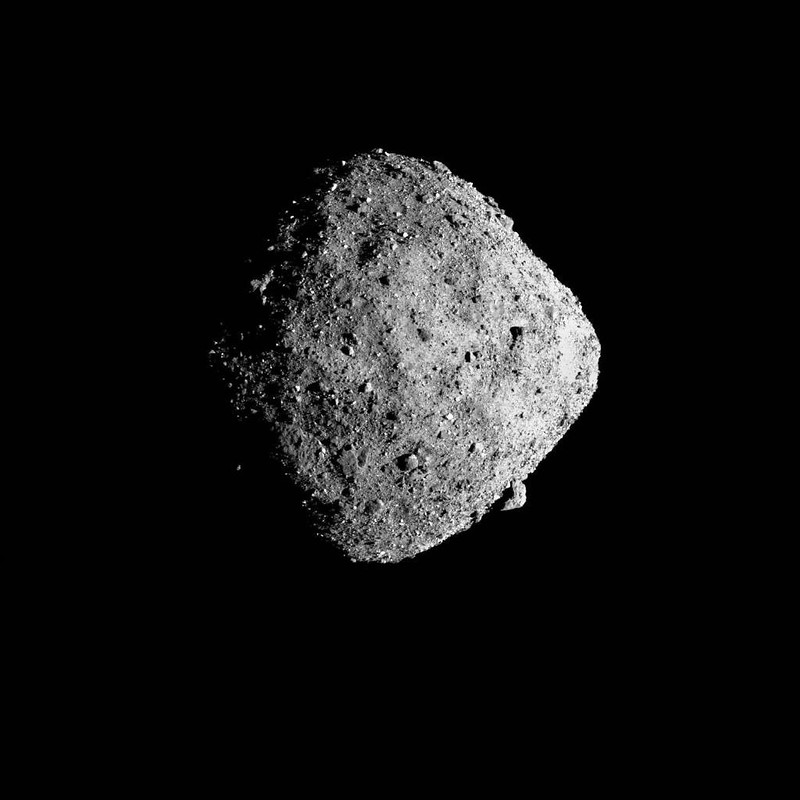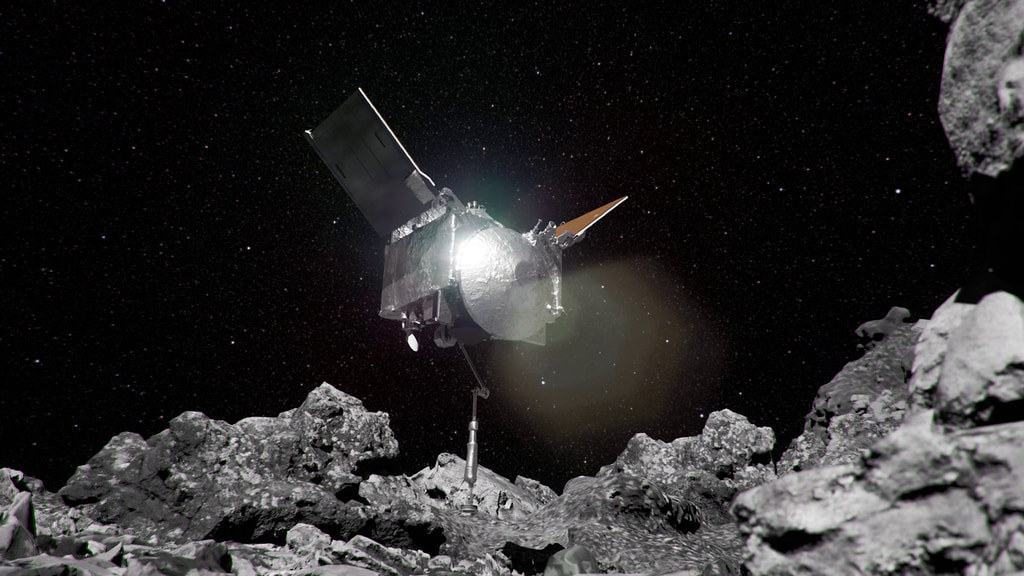The Bennu asteroid is a near-Earth asteroid (NEA) that is approximately 1,100 feet (340 meters) in diameter. It was discovered in 1999 and is thought to be composed of a mixture of rock and metal. The Bennu asteroid is on a collision course with Earth, but the risk of impact is extremely low.
The Bennu asteroid is of interest to scientists because it is thought to be a primitive asteroid. Primitive asteroids are thought to be representative of the building blocks of planets and moons, and they may also have delivered water and other organic molecules to Earth early in its history.
In 2016, NASA launched the OSIRIS-REx mission to study the Bennu asteroid. The OSIRIS-REx spacecraft arrived at the asteroid in 2018 and has been studying it ever since. In 2020, the spacecraft successfully collected a sample of material from the asteroid’s surface. The OSIRIS-REx spacecraft is scheduled to return to Earth with the sample in 2023.
The Bennu asteroid is a fascinating object that is helping scientists to learn more about the early solar system and the origins of life on Earth.

Protecting Earth from the Bennu Asteroid: The Planetary Defense Program’s Preparations
The Bennu asteroid is a near-Earth asteroid (NEA) that is on a collision course with Earth. However, the risk of impact is extremely low, at 1 in 1,750 between 2178 and 2290.
Despite the low risk of impact, the Planetary Defense program is taking steps to prepare for the eventuality of a Bennu impact. The program is closely monitoring the asteroid’s orbit and developing technologies that could be used to deflect it if necessary.
One technology that is being developed is the kinetic impactor. A kinetic impactor is a spacecraft that would be deliberately crashed into the asteroid in order to deflect it. Another technology that is being developed is the gravity tractor. A gravity tractor is a spacecraft that would use its own gravity to deflect the asteroid.
The Planetary Defense program is also working to develop contingency plans in case the Bennu asteroid does impact Earth. These plans would include things like evacuating people from areas that are at risk of impact and providing assistance to those who are affected by the impact.
The Planetary Defense program’s preparations for the Bennu asteroid are an important step in protecting Earth from this potential threat. By monitoring the asteroid’s orbit and developing technologies to deflect it, the program is working to minimize the risk of impact and to keep people safe.
Protecting Earth from Bennu: The Role of the NEO Observations Program and OSIRIS-REx Mission
The Near-Earth Object (NEO) Observations Program and the NASA OSIRIS-REx mission are both playing an important role in protecting Earth from the Bennu asteroid.
The NEO Observations Program is a NASA-funded program that detects, tracks, and characterizes near-Earth objects (NEOs), including Bennu. The program is responsible for monitoring Bennu’s orbit and assessing the risk of impact. The program also works to characterize Bennu, including its size, composition, and rotation. This information is essential for developing strategies to deflect Bennu if necessary.
The OSIRIS-REx mission is a NASA mission to study Bennu. The spacecraft arrived at Bennu in 2018 and has been studying it ever since. In 2020, the spacecraft successfully collected a sample of material from the asteroid’s surface. The OSIRIS-REx spacecraft is scheduled to return to Earth with the sample in 2023.
The data collected by the OSIRIS-REx mission will provide scientists with valuable information about Bennu’s composition and structure, which could help them to better understand the NEO population and to develop strategies for deflecting NEOs if necessary.
Together, the NEO Observations Program and the OSIRIS-REx mission are helping to keep Earth safe from the Bennu asteroid and other NEOs.
How close will the Bennu asteroid approach Earth?
The Bennu asteroid is expected to make its closest approach to Earth on September 24, 2027, when it will pass within 230,000 miles (370,000 kilometers) of our planet. This is closer than some of Earth’s satellites orbit.
Is there a risk of the Bennu asteroid hitting Earth?
The risk of the Bennu hitting Earth is extremely low. NASA estimates that the asteroid has a 1 in 1,750 chance of impacting Earth between 2178 and 2290.
What is the OSIRIS-REx mission?
The OSIRIS-REx mission is a NASA mission to the Bennu asteroid. The mission launched in 2016 and arrived at the asteroid in 2018. The OSIRIS-REx spacecraft has been studying the asteroid and collecting samples from its surface. The spacecraft is scheduled to return to Earth with the samples in 2023.
What will happen if the Bennu asteroid hits Earth?
If the Bennu asteroid were to hit Earth, the impact would be devastating. The asteroid is estimated to have the energy of a nuclear bomb. An impact from the Bennu asteroid would likely create a crater several miles wide and cause widespread damage in the surrounding area.
What is NASA doing to protect Earth from the Bennu asteroid?
NASA is monitoring the Bennu asteroid closely and is developing technologies that could be used to deflect the asteroid if necessary. One technology that is being developed is the kinetic impactor. A kinetic impactor is a spacecraft that would be deliberately crashed into the asteroid in order to deflect it.
Another technology that is being developed is the gravity tractor. A gravity tractor is a spacecraft that would use its own gravity to deflect the asteroid.
What can I do to protect myself from the Bennu asteroid?
The best way to protect yourself from the Bennu is to stay informed about its orbit and impact risk. You can also prepare for a potential impact by having a plan in place. Your plan should include things like where you will go and what you will do if the asteroid is on a collision course with Earth.

Bennu vs Apophis: A Comparison of Two Near-Earth Asteroids
Bennu and Apophis are two near-Earth asteroids (NEAs) that have been the subject of much attention in recent years. Both asteroids are on collision courses with Earth, but the risk of impact is extremely low.
Bennu is a carbonaceous asteroid, which means that it is rich in carbon-based compounds. Carbonaceous asteroids are thought to be the building blocks of planets and moons, and they may also have delivered water and other organic molecules to Earth early in its history.
Apophis is a stony asteroid, which means that it is made up of silicate materials and metals. Stony asteroids are the most common type of NEA, and they are thought to be fragments of larger asteroids that have been broken apart by collisions.
In terms of size, Bennu and Apophis are relatively similar. Bennu is approximately 1,100 feet (340 meters) in diameter, while Apophis is approximately 1,200 feet (370 meters) in diameter.
However, there are some key differences between the two asteroids. Bennu has a much shorter orbital period than Apophis. Bennu orbits the Sun every 433 days, while Apophis orbits the Sun every 377 days. This means that Bennu has more opportunities to pass close to Earth.
Another difference between the two asteroids is their composition. Bennu is a carbonaceous asteroid, while Apophis is a stony asteroid. This means that Bennu is more likely to contain organic molecules, which could be of interest to scientists.
Finally, the risk of impact from Bennu and Apophis is also different. Bennu has a 1 in 1,750 chance of impacting Earth between 2178 and 2290. Apophis, on the other hand, has a much lower chance of impact. Apophis has a 1 in 150,000 chance of impacting Earth in 2068.
Overall, Bennu and Apophis are two very different asteroids. Bennu is a carbonaceous asteroid with a shorter orbital period and a higher risk of impact. Apophis is a stony asteroid with a longer orbital period and a lower risk of impact.
Frequently Asked Questions (FAQs)
Q: What is the difference between a near-Earth asteroid (NEA) and an asteroid that is not near Earth?
A: A near-Earth asteroid (NEA) is an asteroid that has an orbit that brings it within 121 million miles (195 million kilometers) of the Sun. This distance is equal to about 1.3 times the distance between Earth and the Sun. Asteroids that are not near Earth have orbits that are further away from the Sun.
Q: What is the chance that the Bennu asteroid will hit Earth?
A: NASA estimates that the Bennu asteroid has a 1 in 1,750 chance of impacting Earth between 2178 and 2290. This is a very low probability, but it is not zero.
Q: What is the best way to protect myself from the Bennu asteroid?
A: The best way to protect yourself from the Bennu asteroid is to stay informed about its orbit and impact risk. You can also prepare for a potential impact by having a plan in place. Your plan should include things like where you will go and what you will do if the asteroid is on a collision course with Earth.
Conclusion
The Bennu asteroid is a near-Earth asteroid that is on a collision course with Earth. However, the risk of impact is extremely low. NASA is monitoring the Bennu asteroid closely and is developing technologies that could be used to deflect the asteroid if necessary.
